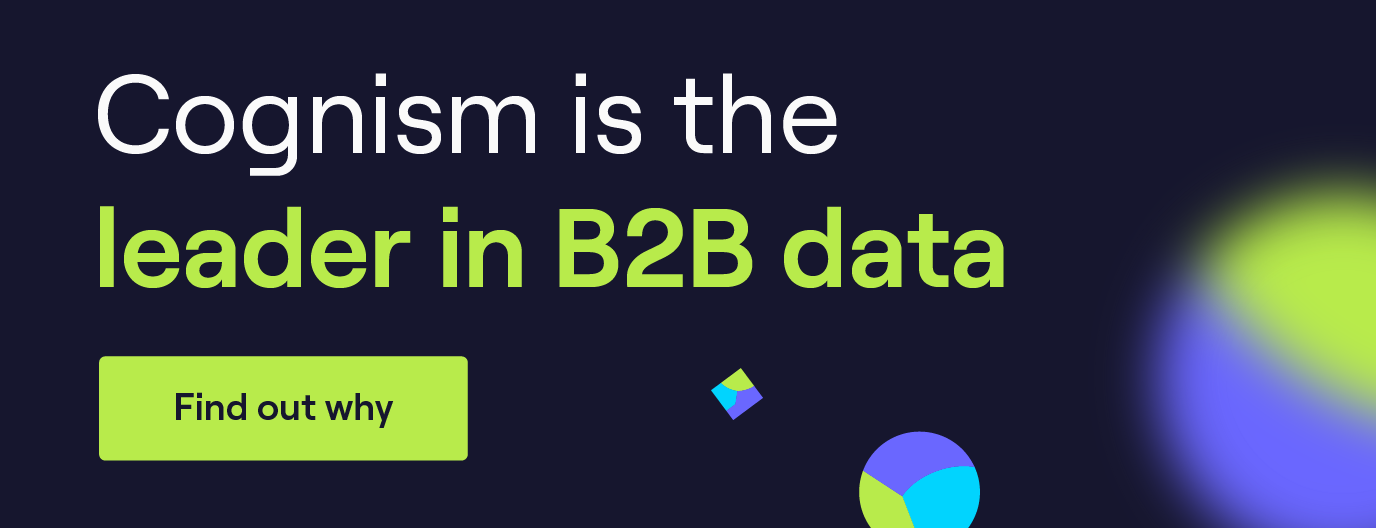8 Ways To Use Customer Data To Drive More Sales & Revenue
For most companies, the problem isn’t that they don’t have enough customer data.
They don’t have enough of the right kind of data: the data that will help them make effective business decisions, inform sales conversations, and ultimately drive more revenue.
In this article, we’re giving you a quick-start guide to better customer data management, explaining:
- The importance of customer data in modern sales motions.
- The different types of data you should focus on.
- The most essential and effective channels for gathering insightful customer data.
Let’s start 👇
What is customer data?
Customer data encompasses all behavioural, demographic, and personal information collected directly from customers or obtained from third parties, such as data vendors or business partners, which can be linked to a specific customer.
For example, you can collect customer data with permission when potential customers visit your website, use mobile apps, fill in surveys, respond to marketing campaigns, or attend events.
But when it comes to establishing customer data insights, consider expanding your perspective.
Details like contact numbers and emails fall into this category, but so does behavioural data, such as:
- Which website pages do prospects spend the most time on?
- How do they interact across the buyer journey?
- How do current customers interact with your product and onboarding sequences?
8 ways to use customer data to drive more sales
Customer data is more than just a list of names and emails. When used correctly, it becomes the lever that sales and marketing teams pull to unlock more pipeline, increase conversion, and expand aggressively.
So, here are seven proven strategies (backed by us) for using customer data to accelerate revenue.
1. Build more targeted lists that match your ICP
Any prospect turned customer all started with knowing exactly who you should be talking to. Firmographics, verified contact data, and clean data feeding your CRM help sales and marketing teams zero in on high-value accounts and decision-makers.
It’s worth mentioning here that tools like Cognism make building targeted lists of potential customers easy. With advanced filters, you can narrow your ICP by industry, headcount, revenue, office location, and more.
 A real-life example of where targeted customer data has worked is for Bright Network. They built £903K in pipeline through improved contact data accuracy.
A real-life example of where targeted customer data has worked is for Bright Network. They built £903K in pipeline through improved contact data accuracy.

Head of Revenue Operations @Bright Network

2. Churn prevention through intent data
Aside from winning new logos, customer data also helps you to retain your current ones. Take intent data, for example, you can use it to prevent churn.
Here are some tips for doing this:
-
Segmentation: Identify which customers are most valuable and monitor their activity closely.
-
Signals: A drop-off in engagement or a sudden lack of response can be a red flag.
-
Proactive outreach: Customer success can re-engage accounts before they leave, while sales can identify upsell/cross-sell opportunities.
For example, at Cognism, we monitor intent keywords related to our competitors. So, if we see a surge in a saved topic that looks like Z***info, we know it’s time to intervene.
Many Cognism customers use enriched accounts and contact data to map buying committees. If one champion leaves, they can quickly engage new decision-makers and prevent churn from derailing renewals.
3. Account expansion through intent data
Similar to preventing churn, intent data from a provider is also helpful in expanding your accounts. Use it to show you exactly where the opportunities are.

-
Spot upsell and cross-sell signals: If an existing customer is researching adjacent solutions or visiting product pages they don’t currently use, that’s a sign they may be ready to expand.
-
Engage the wider buying committee: Intent data helps sales and success teams uncover new contacts in sister departments or business units showing interest.
-
Prioritise high-potential accounts: Focus expansion plays on actively in-market accounts rather than spreading efforts thin across your whole base.
4. Country or vertical expansion needs compliant data
When it comes to international expansion, new markets or verticals mean more revenue, but they also come with challenges.
Different buying behaviours, unfamiliar industries, and compliance regulations can slow you down. That’s where high-quality, compliant customer data makes all the difference.
With the right data, sales and marketing teams can:
-
Pinpoint high-value accounts in new regions or sectors by filtering for firmographics like size, industry, and revenue.
-
Understand the nuances of new markets — for example, who the actual decision-makers are in Germany vs. the UK, or which job titles control budget in pharma vs. manufacturing.
-
Sourcing GDPR—and CCPA-aligned data will help you stay compliant from day one and scale internationally without risk.
-
Launch faster go-to-market plays with clean contact data, so your team doesn’t waste cycles guessing who to reach.
👉 Check out this GTM play from our customer AVEVA, about penetrating new markets.
5. Fewer wasted touchpoints with enriched CRM data
Whenever a rep dials a wrong number, emails a dead inbox, or reaches out to someone who left the company, that’s a wasted touchpoint. Multiply that across a whole team, seriously draining productivity (and pipeline).
Using your CRM with verified contact information, mobile numbers, LinkedIn URLs, and firmographics is a good idea. Sales teams spend less time chasing bounced emails or gatekeepers and more time speaking directly with decision-makers.
What enriched CRM data delivers:
-
Higher connect rates — verified mobiles put reps straight through to buyers.
-
Cleaner workflows — less manual research, more accurate records in Salesforce, HubSpot, or your CRM.
-
More meetings booked — because reps are talking to the right people, faster.
-
Better forecasting — complete, enriched records mean more reliable pipeline visibility.
6. Product usage data supports upsell and cross-sell
Customer data isn’t just external. How your customers use your product is one of your most powerful revenue signals. You can spot opportunities to expand accounts, prevent churn, and align sales and customer success around the right plays by tracking usage patterns.
How product usage data drives revenue:
-
Identify expansion opportunities — if a customer is maxing out licenses, adopting new features, or scaling activity across departments, that’s a sign they’re ready for an upsell or cross-sell.
-
Spot churn risks early — sudden drop-offs in logins, feature adoption, or engagement can trigger proactive outreach from customer success.
-
Prioritise account management — usage data helps CSMs know which accounts to focus on for renewals vs. which ones to nurture for growth.
-
Tailor ABM campaigns — marketing can use product insights to craft targeted expansion campaigns, focusing on the features or modules customers engage with most.
Internally, we at Cognism use the Avidity Scoring system for product usage and engagement. Each customer gets a score of 100, and we adjust our nurture campaigns based on the score. For example, if we notice a sharp drop in the customer’s Avidity Scoring, our CSMs will reach out to check in and help the customer make better use of the product.
7. Run personalised customer campaigns with the help of ABM
Account-based marketing (ABM) doesn’t have to help you acquire new accounts. You can use it to connect with your existing ones, too. With the correct customer data, you can design ABM campaigns that speak directly to your customers’ evolving needs and open the door to upsell and cross-sell opportunities.
How customer data makes ABM expansion work:
-
Map the full buying committee — enrichment data ensures you’re not reliant on one champion. You can still reach the rest of the decision-making unit if they leave or change roles.
-
Segment by potential growth — firmographic and usage data show you which accounts have budget, headcount, or product adoption trends that make them prime targets for expansion.
-
Personalise at scale — intent data highlights what topics your existing customers are researching, while behavioural signals show what they care about most inside your product. This fuels hyper-relevant ABM messaging.
-
Sync sales and marketing — when both teams work from a unified, enriched account view, expansion campaigns hit harder and close faster.
8. Customer usage data used for new launches
Another way you can use customer product usage data is to inform new launches.
Before launching our Data as a Service (DaaS) offering, we used product data from Cognism users to inform our email contact list. We looked at the exact usage of the account and then tailored our message to their product use case.
Why is customer data important?
Customer sales data helps businesses better understand customers, improve their products and services, and drive growth and profitability.
Here’s why the value of customer data in B2B matters:
Better reporting
Access to a database of accurate data is a game-changer for sales and marketing teams! It allows you to dig into analytics if and when needed, and when you have a question you want answered, the data is already organised in a way that makes it easy to create an insightful report.
You can then monitor these reports regularly to track and measure the impact of any initiatives you implement.
However, better reporting capabilities are essential to maximising your customer data profiles. This means quickly accessing and analysing data in real-time and generating clear and visually appealing reports that provide actionable insights.
One way to improve customer data reporting is to implement a robust CRM (Customer Relationship Management) system. A CRM system can help you track and manage customer interactions, store customer information, and generate reports that provide valuable insights into customer behaviour and preferences.
Just be sure to keep your data updated by enriching your records frequently.
Personalisation for larger deals
Data allows businesses to create personalised experiences for their customers.
Using these insights, you can analyse customer preferences, behaviours, and purchase history. Moreover, businesses can tailor their marketing messages, recommendations, and promotions to individual customers, increasing the likelihood of conversion and customer loyalty.
This is especially effective when creating ABM campaigns targeting hard-to-get big fish accounts.
Once you have the right enterprise customer data for these accounts, you can create targeted marketing campaigns, personalised home pages, and exclusive promotions that resonate with each customer on a personal level.
Next-level targeting
With the right sales and marketing data, businesses can segment their customer base and target specific audiences with relevant marketing campaigns.
You can better understand your customers’ preferences, behaviours, and needs using customer data segmentation. This allows you to create targeted marketing campaigns that speak directly to the unique interests of different customer segments.
For example:
A recruiter may use B2B data to identify segments of an audience looking for a role in SaaS Sales over a role in SaaS marketing. With this information, they can tailor their marketing messages and promotions specifically for this audience, increasing the likelihood of connecting with the right talt to fill a vacant position for a client.
Improved decision making
A customer data strategy helps businesses make more informed decisions by discovering valuable insights into customer preferences, behaviours, and trends. This allows companies to tailor their products and services to meet the needs of their target audience.
For example:
By analysing customer purchase history and feedback, businesses can identify which products are most popular and which may need improvement. This information can then influence product development, pricing strategies, and marketing campaigns.
Encourage customer loyalty
Customer journey data can feed insights back to customer-facing teams (sales, support, success), and you can make meaningful improvements to your customer experience and retention rates.
For instance, delving into customer support ticket trends can help you uncover common problems new users face. You can address them with on-demand content, better onboarding materials or workflows, or sales-driven implementation sessions.
By understanding customer preferences, behaviours, and needs through data analysis, businesses can consistently engage with customers based on their data-driven preferences and build long-lasting relationships.
Better understanding of the product funnel
Digging into engagement data, such as how prospects engage with sales assets, social media publications, emails, etc., can help you optimise your existing channels and campaigns.
The same goes for engagement with onboarding materials and the adoption of product features, which help you learn more about the product funnel and determine where to focus (acquisition, engagement, or monetisation).
Types of customer data
Collecting and analysing different types of customer data is a basis for creating a masterful data driven marketing plan.
Segmentation precedes efficiency, so breaking up your customer data helps you to focus on what counts.
There are four types that businesses typically collect to power their strategies:
/Customer%20data/types_of_customer_data_circular_style_graphic.webp?width=500&height=500&name=types_of_customer_data_circular_style_graphic.webp)
Attitudinal data
Attitudinal data relates to customers’ thoughts and feelings about your brand, product, market, and competitors.
Attitudinal data can provide valuable insights into how customers perceive your brand and products, helping you identify areas for improvement and opportunities for growth. By analysing attitudinal data, you can better understand your customers’ needs, wants, and preferences.
These are often first-hand accounts; they can be relatively subjective and qualitative, but they’re still incredibly useful input for go-to-market strategies.
Examples of attitudinal data points include:
- Customer complaints.
- Public reviews.
- Survey responses related to the buying journey.
- Purchasing preferences.
- Customer satisfaction scores.
Behavioural data
Behavioural data is how customers act, helping you find underlying patterns that inform sales, marketing, and product strategies.
Product usage data is an important subcategory of behavioural data, where you’re looking at user behaviour like:
- Regularly repeated actions.
- How often users log in.
- Task completion.
- Devices used to access your software.
- Feature adoption.
However, there’s also a tonne of customer data you must capture before prospects become customers.
Qualitative website engagement data, provided by heat mapping software tools like Hotjar, can provide valuable insights into how prospects engage with content and what messages best connect with buyer needs.
Then, there’s transactional data, which includes data points like:
- Subscription details.
- Previous purchase.
- Cart abandonment information.
- Average order value.
This is all behavioural data, as it speaks to how customers act or behave. This information can help you understand how customers engage with your products or services, what drives their purchasing decisions, and where they may encounter obstacles in the customer journey.
Engagement data
Engagement data is crucial for informing customer data strategies and understanding how customers interact with your brand and B2B marketing efforts. By analysing this data, you’ll gain insights into what resonates with your audience, what isn’t working, and where there may be opportunities for improvement.
Instead of using heat mapping tools to understand individual user behaviour, engagement data covers large-scale engagement with your various marketing channels.
Common examples of engagement data you can target include:
- Website page visits.
- Content asset conversion rates.
- Ad engagement.
- Click-through rates (CTRs).
- Email engagement.
- Social media interactions such as likes, shares, and comments.
- Survey participation rates.
- Event attendance.
- Overall customer satisfaction scores.
For example:
If a particular social media post receives a high engagement rate, it may indicate that the content resonates well with your audience. On the other hand, if an email campaign has a low click-through rate, it may suggest that you need to adjust the messaging or call-to-action.
Personal data
Finally, we’ve got personal data, which is information related to a specific individual (each of your customers). It allows businesses to personalise customer interactions and provide a more tailored experience.
We can divide this into two categories:
- Personally Identifiable Information (PII): Data used to identify a person, such as their name, address, phone number, email address, etc.
- Non-Personally Identifiable Information (Non-PII): More generic data that can’t be used to identify a person, such as their IP address or device ID.
Though this data is personal, it still has the potential to provide valuable insights. For example, gender or age information can inform social media ad targeting parameters.
In B2B, compliance laws like GDPR and CCPA ensure that contact data collected via customer data platforms like Cognism, ZoomInfo and Lusha is only related to businesses.
This is due to the increasing concern over privacy and data security. Businesses must handle data responsibly and ensure that contacts consent to the use of their data for sales and marketing purposes. You can also leverage insider alerts to secure robust protection against data breaches.
How do you collect customer data?
Companies can collect customer data in several ways. We’ve condensed them all into a neat infographic, but scroll on to read more. 👇
/Customer%20data/where_to_collect_customer_data_infographic_style.webp?width=700&height=1027&name=where_to_collect_customer_data_infographic_style.webp)
Online forms
Companies often use online forms on their websites or social media platforms to gather customer information.
These forms typically ask for basic information such as name, email address, and phone number.
Surveys
Surveys are a great way to collect more detailed customer information about their preferences, needs, and experiences with your products or services.
You can conduct surveys via email, social media, or your website.
Website analytics
Tools like Google Analytics can provide valuable insights into how customers interact with your website, what pages they visit most frequently, and how long they spend on each page.
Customer feedback
Encouraging customers to provide feedback through reviews, ratings, and comments can also provide valuable data on their experiences with your brand.
Social media monitoring
Monitoring social media platforms for mentions, comments, and interactions can help you understand how customers perceive your brand and what they say about it.
Email marketing
Tracking email open rates, click-through rates, and engagement metrics can provide valuable data on how customers respond to your email campaigns.
Purchase history
Tracking customer purchases, order history, and product preferences can help you understand their buying habits and tailor your marketing efforts accordingly.
Customer data companies
Customer data platforms are businesses that specialise in collecting and selling customer data to other companies for various purposes.
But it’s not just about selling B2B data. These tools also protect, manage and enrich customer data while ensuring compliance.
For example, Cognism ensures customer data protection by following strict compliance laws. The tool offers unrestricted mobile phone numbers and B2B emails of people you want to do business with. ( Subject to a generous fair usage policy.)
Keen to learn more? 📞 Book a call with a data expert today, or check out our pricing page.
Get quality B2B customer data from Cognism
When it comes to customer data collection, Cognism is an excellent option.
You can use our technology to:
- Calculate your TAM and generate complete target account and contact lists.
- Enrich your leads database and plug any gaps with information straight from Cognism’s compliant data asset.
- Help your revenue team meet performance targets with accurate direct dials and mobile numbers.
- Enhance your workflows with Cognism’s data and CRM/revenue tech stack integration.
Ready to learn more? Book a demo with a data expert today 👇


/CRM%20growth/crm-growth-resource-card.webp)
